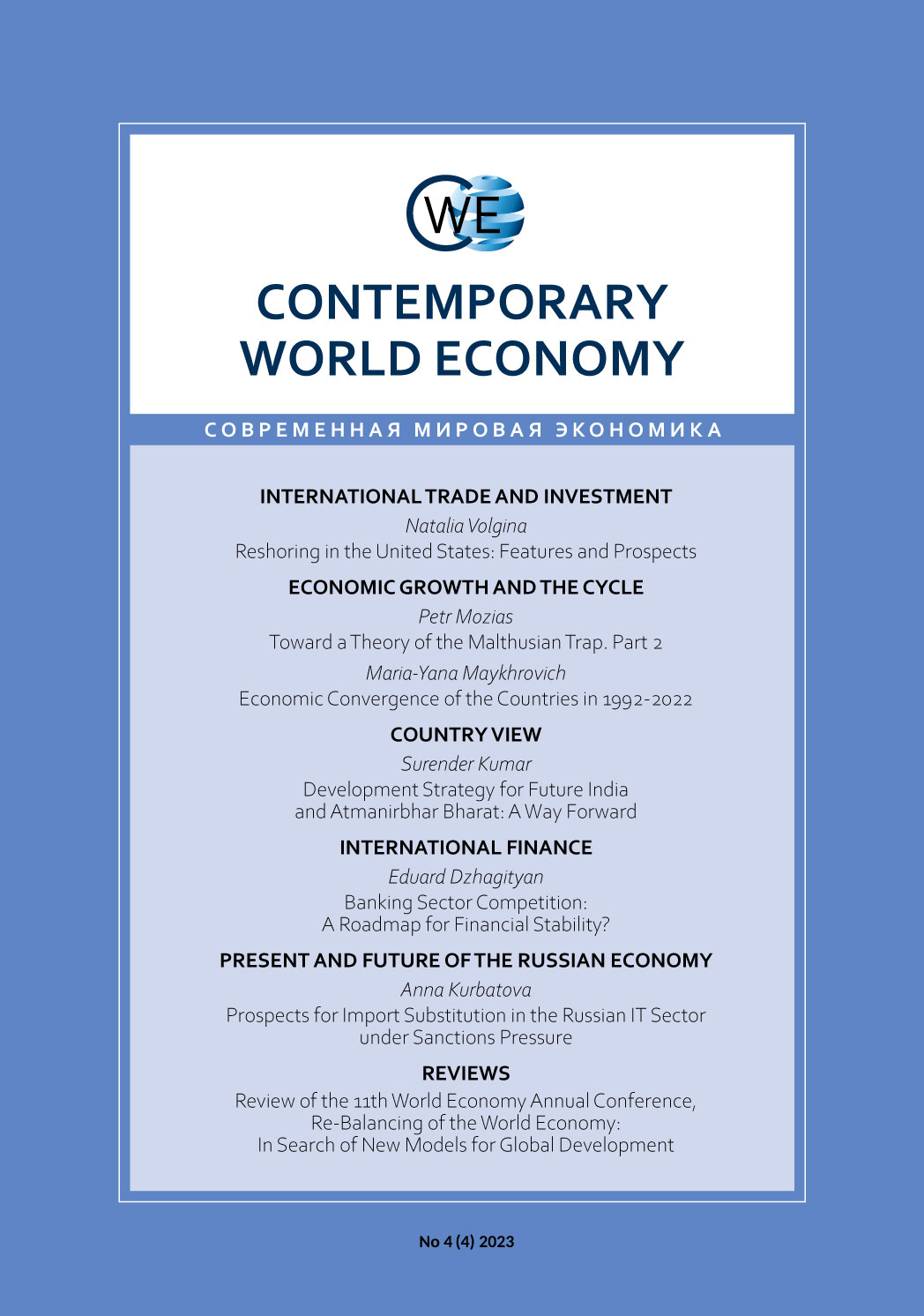Toward a Theory of the Malthusian Trap. Part 2
Abstract
Economic historians nowadays argue that economic growth in the world was extremely slow and unsustainable until the beginning of the Industrial Revolution in the late eighteenth century. This article traces how the efforts of many economists and historians have gradually developed the concept of the “Malthusian trap” to explain the centuries-long relative stagnation of agrarian society. In the case of traditional economies, cliometric studies generally confirm Thomas Malthus’s ideas about the compensation of the positive impact of technological progress on per capita income by population growth. Modern scholars supplement them by analyzing the social structure of the society in the Malthusian trap, as well as its inherent institutions of redistribution, and the periodic flourishings and declines of proto-industry and trade that took place in those times. The article shows the logical interrelation of these elements within the Malthusian dynastic cycle. The concept of Malthusian trap is compared with the Marxist vision of the historical process. It is shown that positive insights of the Marxist approach can be implanted in the modern theory.
Downloads
References
Acemoglu, D., Robinson, J., 2012. Why Nations Fail: The Origins of Power, Prosperity, and Poverty. N.Y.: Crown Publishers.
Afanasyev, V.S., 1988. Stages of Development of Bourgeois Political Economy: Essay of Theory. Moscow: Ekonomika (in Russian).
Azariadis, C., Stachurski, J., 2005. “Poverty Traps.” In: Aghion, Ph., Durlauf, S. (eds.). Handbook of Economic Growth. Vol. 1A. Amsterdam, etc.: Elsevier. P. 295-384.
Boserup, E., 1975. The Impact of Population Growth on Agricultural Output. Quarterly Journal of Economics. Vol. 89. No. 2. P. 257-270.
Bryant, J., 2006. The West and the Rest Revisited: Debating Capitalist Origins, European Colonialism, and the Advent of Modernity. Canadian Journal of Sociology. Vol. 31. No. 4. P. 403-444.
Cambridge Economic History of Europe in the New and Modern Times, 2014. Vol. 1: 1700-1870. Moscow: Gaidar Institute Publishing House (in Russian).
Chirot, D., 1985. The Rise of the West. American Sociological Review. Vol. 50. No. 2. P. 181-195.
Clark, G., 2007. A Farewell to Alms: A Brief Economic History of the World. Princeton: Princeton Univ. Press.
Coleman, D., 1983. Proto-Industrialization: A Concept Too Many. Economic History Review. Vol. 36. No. 3. P. 435-448.
Crafts, N., Mills, T., 2009. From Malthus to Solow: How Did the Malthusian Economy Really Evolve? Journal of Macroeconomics. Vol. 31. No. 1. P. 68-93.
de Vries, J., 2008. The Industrious Revolution: Consumer Behavior and the Household Economy, 1650 to the Present. N.Y.: Cambridge Univ. Press.
Elvin, M., 1973. The Pattern of the Chinese Past. Stanford: Stanford Univ. Press.
Engels, F., 1986. Anti-Dühring. Herr Eugen Düring’s Revolution in Science. In: Marx, K., Engels, F. Selected Works. Vol. 5. M.: Politizdat. P. 1-302 (in Russian).
Gaidar, Ye.T., 2005. A Long Time. Russia in the World: Essays on Economic History. Moscow: Delo (in Russian).
Galor, O., 2005. “From Stagnation to Growth: Unified Growth Theory.” In: Aghion, Ph., Durlauf, S. (eds.). Handbook of Economic Growth. Vol. 1A. Amsterdam, etc.: Elsevier. P. 171-293.
Goldstone, J., 2002. Efflorescences and Economic Growth in World History: Rethinking the “Rise of the West” and the Industrial Revolution. Journal of World History. Vol. 13. No. 2. P. 323-389.
Ilyushechkin, V.P., 1990. Exploitation and Property in Pre-Capitalist Class Societies (Experience of System-structural Research). Moscow: Nauka (in Russian).
Kelly, M., 1997. The Dynamics of Smithian Growth. Quarterly Journal of Economics. Vol. 112. No. 3. P. 931-964.
Kobishchanov, Y.M., 1992. Theory of a Large Feudal Formation. Voprosy Istorii. No. 4-5. P. 57-72 (in Russian).
Kogel, T., Prskawetz, A., 2001. Agricultural Productivity Growth and Escape from Malthusian Trap. Journal of Economic Growth. Vol. 6. No. 4. P. 337-357.
Lee, R., Anderson, M., 2002. Malthus in State Space: Macroeconomic-demographic Relations in English History, 1540 to 1870. Journal of Population Economics. Vol. 15. No. 2. P. 195-220.
Lewis, W.A., 1954. Economic Development with Unlimited Supplies of Labor. The Manchester School of Economic and Social Studies. Vol. 22. No. 2. P. 139-191.
Lucas, R., 2004. Lectures on Economic Growth. Cambridge, MA: Harvard Univ. Press.
Lueger, T., 2018. The Principle of Population vs. the Malthusian Trap. A Classical Retrospective and Resuscitation. Available at: https://ideas.repec.org/p/zbw/darddp/232.html (accessed September 12, 2023).
Maddison, A., 2007. Contours of the World Economy, 1-2030 AD: Essays in Macro-Economic History. Oxford: Oxford Univ. Press.
Madsen, J., Robertson, P., Ye Longfeng, 2019. Malthus Was Right: Explaining a Millennium of Stagnation. European Economic Review. Vol. 118. No. C. P. 56-68.
Malthus, T., 2022. The Principle of Population. Moscow: Nashe Zavtra (in Russian).
Marx, K., 1978. Theories of Surplus Value. (4th volume of “Capital”). Part 2. Moscow: Politizdat (in Russian).
Marx, K., 1980. Economic Manuscripts 1857-1861 (the original version of “Capital”). Part 1. Moscow: Politizdat (in Russian).
Marx, K., 1983. Capital. Critique of Political Economy. Vol. 1. Moscow: Politizdat (in Russian).
Meliantsev, V.A., 1996. East and West in the Second Millennium: Economy, History and Modernity. M.: Moscow State Univ. Press (in Russian).
Mendels, F., 1972. Proto-industrialization: The First Phase of the Industrialization Process. Journal of Economic History. Vol. 32. No. 1. P. 241-261.
Mokyr, J., 1977. Demand vs. Supply in the Industrial Revolution. Journal of Economic History. Vol. 37. No. 4. P. 981-1008.
Mokyr, J., 1992. The Lever of Riches. Technological Creativity and Economic Progress. Oxford: Oxford Univ. Press.
Mugruzin, A.S., 1986. The Role of Natural and Demographic Factors in the Dynamics of the Agrarian Sector of Medieval China (To the Question of Cyclicality of Pre-Capitalist Production). Historical Factors of Social Reproduction in the Countries of the East. Moscow: Nauka. P. 11-44 (in Russian).
Nefedov, S.A., 2012. Economic Laws of History. Voprosy Ekonomiki. No. 12. P. 118-134 (in Russian).
Nelson, R., 1956. A Theory of the Low-level Equilibrium Trap in Underdeveloped Economies. American Economic Review. Vol. 46. No. 5. P. 894-908.
Nureev, R.M., 1979. Antique Polis: A Brief Political and Economic Characterization. The Economic Role of the State in the Conditions of Antagonistic Modes of Production. Moscow: Moscow State Univ. Press. P. 33-55 (in Russian).
Petrov, A.M., 1986. Foreign Trade of Ancient and Medieval Asia in Russian Oriental Studies (Literature Review and an Attempt of a New Approach to the Study of the Problem). Historical Factors of Social Reproduction in the Countries of the East. Moscow: Nauka. P. 149-183 (in Russian).
Polanyi, K., 1944. The Great Transformation: The Political and Economic Origins of Our Time. Boston: Beacon Press.
Polanyi, K., 1957. “The Economy as Instituted Process.” In: Trade and Market in the Early Empires. Economies in History and Theory. Glencoe: Free Press. P. 243-270.
Pomeranz, K., 2000. The Great Divergence: China, Europe and the Making of the Modern World Economy. Princeton: Princeton Univ. Press.
Rostow, W., 1971. The Stages of Economic Growth. A Non-Communist Manifesto. Cambridge, MA: Cambridge Univ. Press.
Tisdell, C., Svizzero, S., 2015. The Malthusian Trap and Development in Pre-Industrial Societies: A View Differing from the Standard One. Available at: https://www.researchgate.net//publication/ (accessed September 12, 2023).
Tokei, F., 1975. Toward a Theory of Social Formations. Moscow: Progress (in Russian).
Utchenko, S.L., 1977. Political Doctrines of Ancient Rome III-I centuries BC. Moscow: Nauka (in Russian).
Vasiliev, L.S., 1998. History of the East. Vol. 1. Moscow: Higher School (in Russian).
Voightlander, N., Voth, H.J., 2006. Why England? Demographic Factors, Structural Change and Physical Capital Accumulation during the Industrial Revolution. Journal of Economic Growth. Vol. 11. No. 4. P. 319-361.
Voightlander, N., Voth, H.J., 2009. Malthusian Dynamism and the Rise of Europe: Make War, Not Love. American Economic Review: Papers and Proceedings. Vol. 99. No. 2. P. 248-254.
Zarin, V.A., 1991. West and East in World History XIV-XIX Centuries: Western Concepts of Social Development and the Formation of the World Market. Moscow: Nauka (in Russian).



1.jpg)

